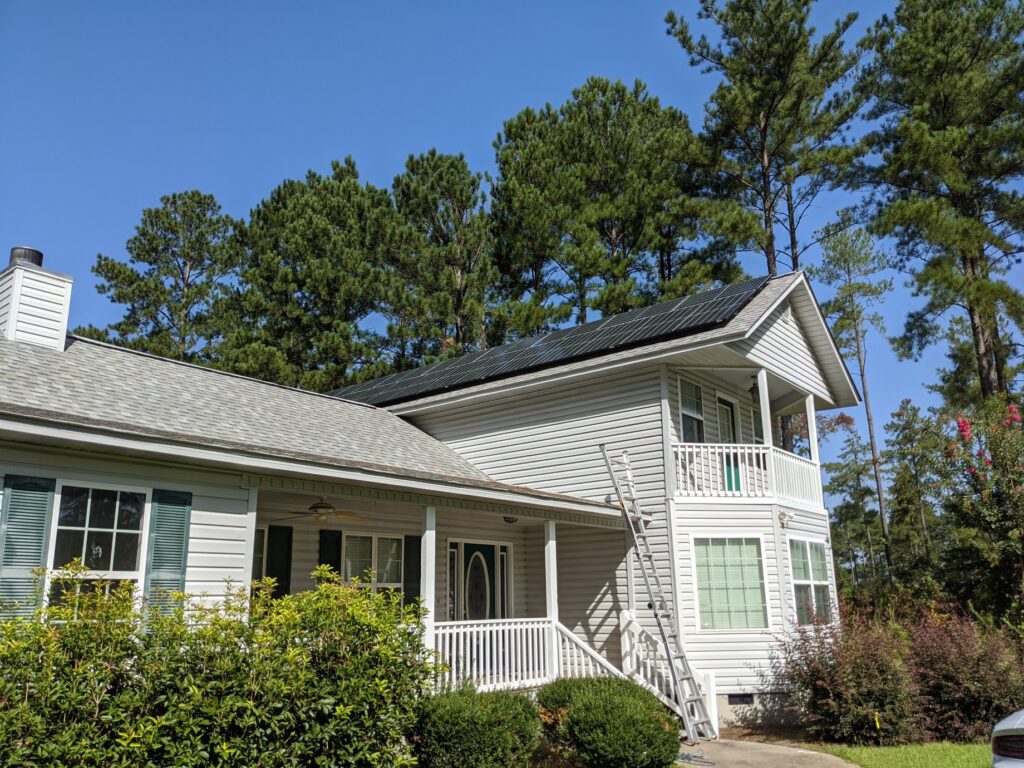Solar energy is great because it can produce clean electricity right on sight. In ideal conditions, solar panels installed on a roof can generate enough electricity to run an entire household. Unfortunately, conditions are not always ideal. Roofs across the country are all different with variables like direction, angle, and material.
Should I Install Solar Panels on My Roof?
Because the benefits of solar energy vary on a case to case basis, this leaves many people wondering, “Should I install solar panels on my roof?” Below, we will outline some of the factors that create ideal conditions for solar panels.
Best Direction for Solar Panels to Face
In the United States, the best direction for solar panels to face is south. Because we are in the Northern Hemisphere, southern facing solar panels will capture the most sunlight throughout the day, as the sun travels along the Earth’s equator. Additionally, solar panels facing east or west can also capture a significant amount of sunlight. Depending on your individual situation, you can utilize a combination of south, east, and west facing solar panels. If you are in a region where the electric utility bills for electricity at higher rates during afternoon “Time of Use” periods, then you may especially benefit financially from western facing panels.
Types of Roofing You Can Install Solar Panels On
Solar panels can be installed on nearly every kind of roof, by utilizing special attachments for mounting on various materials. With the exception of potential fire hazards like thatch and wood, most residential and commercial buildings in the United States are solar panel ready. We can install solar panels on:
- Asphalt Shingles
- Concrete Shingles
- Slate Roofs
- Steel Roofs
- Tile Roofs
- Metal Roofs
- and More
Solar Panels on a Metal Roof
Believe it or not, we think that a standing seam metal roof is optimal for solar panels. Standing seam metal roofs are great, because they do not require any roof penetration when installing the system. Instead, the racking is simply attached to the top of the durable metal material.
Solar Panel Angle for Maximum Efficiency
Technically, the solar panel angle for maximum efficiency is equal to the exact latitude of the installation’s location. This means that a roof in Thomasville, Georgia is ideal for solar if it is angled at roughly 30°. With that said, solar panels are very efficient in capturing sunlight when they are mounted anywhere between 30 and 45 degrees.
Can you Install Solar Panels on a Flat Roof?
Yes. You can install solar panels on a flat roof. A flat roof presents the opportunity to raise the solar panels at the perfect angle for solar electricity generation. In many ways, a solar panel system on a flat roof is essentially the same as a ground mounted system, just on top of your home.
Solar Panel Roof Mounts vs. Ground Mounts
If your roof is not ideal for solar, then you are not necessarily out of luck. Many people choose, and some even prefer, ground mounted solar panels over traditional roof mounts. Below, we will explore the pros and cons of ground mounted solar panels.
Pros of Ground Mounted Solar Panels
- Can be set up in the ideal direction for sunlight hours
- Will be titled at the optimal production angle
- Easy access for cleaning and maintenance
- Unaffected if you need to replace your roof
Cons of Ground Mounted Solar Panels
- Takes up potentially valuable yard space
- Additional materials make it initially more expensive
- May require extra protection against trespassing or animal damage
What about Solar Trackers?
A solar tracker is essentially a “smart” ground mounted solar panel system. Solar trackers are designed to shift and move so that they are always generating as much electricity as possible. For most residential systems, solar trackers are simply too expensive to be cost efficient. In most cases, money can be saved without sacrificing production levels simply by adding a few more panels.
Bundling Your Roof and Solar Panels for a Tax Credit
Another thing to keep in mind is that during the 30+ year lifespan of your solar panels, you will probably have to replace your roof. Depending on your installer, there may be an added cost to remove and replace your panels. If you install solar panels at the same time that you replace your roof, then a portion of your roofing costs may actually be covered by the federal solar tax incentive. Check with your CPA for your solar tax incentive eligibility.
Conclusion: Ground Mounts vs Roof Mounts
As you can see, there are many benefits of choosing a ground mounted solar system, even if it comes at a larger upfront cost. Ideal conditions for sunlight allow ground mounted systems to produce the maximum amount of electricity. Although roof mounted systems are more popular, some people even prefer ground mounted systems for simple aesthetic reasons. If you’re not sure which type of installation is best for your electricity needs, feel free to contact us for a free consultation.

